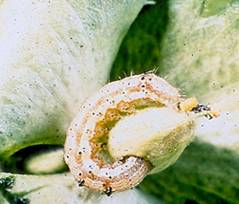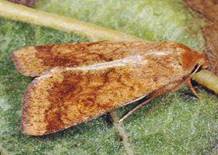Crop Protection :: Cash Crop :: Pest of Cotton
| Fruit borer: Helicoverpa armigera |
Symptoms of damage
- Bolls showing regular, circular bore holes
- Larvae seen feeding on the boll by thrusting their heads alone inside and leaving the rest of the body outside
- Presence of granular faecal pellets outside the bore hole
- A single larva can damage 30-40 bolls
Identification of the pest
- Egg- Spherical in shape and creamy white in colour, present singly
- Larva- Shows colour variation from greenish to brown. It has dark brown grey lines on the body with lateral white lines and also has dark and pale bands.
- Pupa- Brown in colour, occurs in soil, leaf, pod and crop debris
Adult :
- Light pale brownish yellow stout moth
- Forewings are olive green to pale brown in colour with a dark brown circular spot in the centre
- Hind wings are pale smoky white with a broad blackish outer margin
|
 |
| Feeding injury |
|
 |
| Circular bore hole |
|
|
Management
- ETL: One egg or one larva/plant
Monitoring:
- Pest monitoring should be intensified at farm, village and state level by using light traps, pheromone traps and in situ assessments by roving and fixed plot surveys. For management, an action threshold of one egg/plant or 1 larva/plant may be adopted.
Cultural practices:
- Synchronised sowing of cotton preferably with short duration varieties in each cotton ecosystem
- Avoid continuous cropping of cotton both during winter and summer seasons in the same area as well as ratooning
- Avoid monocropping. Growing of less preferred crops like greengram, blackgram, soyabean, castor, sorghum etc., along with the cotton as intercrop or border crop or alternate crop to reduce the pest infestation
- Removal and destruction of crop residues to avoid carry over of the pest to the next season, and avoiding extended period of crop growth by continuous irrigation
- Optimising the use of nitrogenous fertilizers that will not favour moth multiplication of the pest
- Judicious water management for the crop to prevent excessive vegetative growth and larval harbourage
Biological control:
- Application of Nuclear Polyhedrosis Virus (NPV) at 3 x 1012 POB /ha in evening hours at 7th and
12th week after sowing
• Bacillus thuringiensiskurstaki 750-1000 g/ha
• Bacillus thuringiensisserovarkurstaki (3a, 3b, 3c) 5%WP 500-1000 g/ha
• Beauveriabassiana1.15% WP 400 g/ha
• Conservation and augmentation of natural predators and parasitoids for effective control of the pest.
• Inundative release of egg parasitoid, Trichogrammaspp., at 6.25 cc/ha at 15 days interval 3 times from 45 DAS
• Egg-larval parasitoid, Chelonusblackburniiand Predator Chrysoperlacarneaat 1,00,000/ha at 6th, 13th and 14th week after sowing.
• ULV spray of NPV at 3 x 10 12 POB /ha with 10% cotton seed kernel extract, 10% crude sugar, 0.1% each of Tinopal and Teepol for effective control of Helicoverpa
Note: Dicofol, methyl demeton, monocrotophos and phosalone are comparatively safer to Chrysoperlalarva
recording low egg mortality
Chemical control:
- Discourage the indiscriminate use of insecticides, particularly synthetic pyrethroids
- Use of proper insecticides that are comparatively safer to natural enemies such as phosalone at the correct dosage and alternating different groups of insecticides for each round of spray
- Avoid combination of insecticides as tank mix
- Adopt proper delivery system using spraying equipments like hand compression sprayer, knapsack sprayer and mist blower to ensure proper coverage with required quantity of spray fluid and avoid ULV applications or Akela spray applications
- Proper mixing and preparation of spray fluid for each filling of spray fluid tank
At early stages of square formation apply one of the following insecticides
- Acephate 75% SP 780 g/ha
- Azadirachtin 0.03% EC 500 ml/ha
- Carbaryl
10% DP 25 kg/ha
- Chlorantraniliprole 18.5% SC 150 ml/ha
- Chlorpyriphos 20% EC 1250
ml/ha
- Diflubenzuron 25% WP 300 g/ha
- Emamectin benzoate 5% SG 190-220 g/ha
- Fipronil 5% SC 2000 ml/ha
- Flubendiamide 20% WG 250 g/ha
- Flubendiamide 39.35% SC 100-125 ml/ha
- Indoxacarb 14.5% SC 500 ml/ha
- Lufenuron 5.4% EC 600 ml/ha
- Novaluron 10% EC 1000 ml/ha
- NPV of H. armigera0.43% AS 400-600 ml/ha
- Profenofos 50% EC 1750-2500 ml/ha
- Pyridalyl10% EC 1500-2000 ml/ha
- Spinosad 45.0% SC 165-220 ml/ha
- Thiodicarb 75% WP 1000 g/ha
During bolling and maturation stage, apply any one of the following insecticides (1000 l of spray fluid/ha):
- Quinalphos 25 EC 2.0 l/ha
- Carbaryl 50 WP 2.5 kg/ha
- Pyraclofos 50 EC 1.5 l/ha
|
|
|
|






